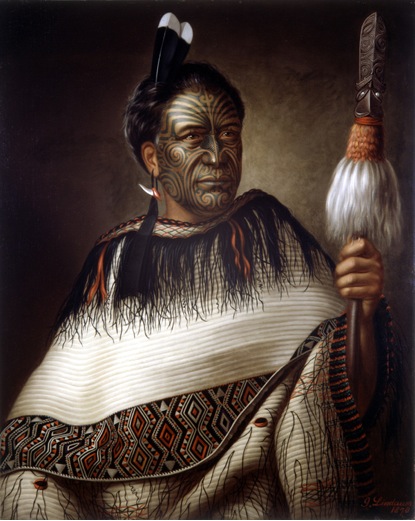Ta Moko
Tā moko is the process, moko is the product. It has its origins in Maori mythical narrative, when a young man, Mataora, ventured into the Underworld to win back the affections of his wife Niwareka. Whilst there, the people with engraved faces laughed at his painted face, so Niwareka's father Uetonga carved a moko onto his face and offered to teach him the art. Forgiven and initiated, Mataora returned with his wife to the world of humankind with knowledge of moko."It's like turning your soul inside out for everyone to see and it keeps you humble. You don't need to talk about yourself so much because it is there for people to see for themselves."
Māori men traditionally wore tattoos on the waist, knees and buttocks as well as on the face. These bodily markings were not unlike the Samoan pe'a (trouser tattoo) and were similarly applied at a young age, except they consisted of spirals rather than lines and dots. Yet it is the facial moko that is loaded with the most cultural significance. The designs are not simply abstract designs on the skin but an imprint of Māori culture and philosophy. The chiselled and tattooed spirals and lines on the faces of the Māori narrate unambiguously – to those capable of understanding them – a person's genealogy and birthright (whakapapa), the story of that person's life so far (such as marital status or distinctions gained), and their personal attributes.
 Portrait of Ngairo Rakai HikuroaOne reason for applying this information to the face is practicality. In other parts of tropical Polynesia tattoos are worn all over the body. However, New Zealand has a temperate, cool climate and the body is more often than not covered in clothing so the face is the most obvious platform for this communication. Facial tattooing also played its part in war where it acted as a natural camouflage and gave warriors a terrifying appearance, especially when seen against the whites of the teeth and eyes during war dances and songs. Finally also, the capacity for pain and endurance displayed by a man undergoing facial moko earned him respect among his peers and favour among female admirers.
Portrait of Ngairo Rakai HikuroaOne reason for applying this information to the face is practicality. In other parts of tropical Polynesia tattoos are worn all over the body. However, New Zealand has a temperate, cool climate and the body is more often than not covered in clothing so the face is the most obvious platform for this communication. Facial tattooing also played its part in war where it acted as a natural camouflage and gave warriors a terrifying appearance, especially when seen against the whites of the teeth and eyes during war dances and songs. Finally also, the capacity for pain and endurance displayed by a man undergoing facial moko earned him respect among his peers and favour among female admirers.
At one time, moko was restricted to men of high-status and warriors. The practice declined from the mid-19th century and was banned by colonial governments (although the distinctive chin moko worn by Māori women survived in some remote areas). Yet across the world in the last few decades, both the academic and public archive of global body arts has led to reclamation movements of various kinds. The Māori revival that began in the 1970s, although linked to the more general revival of Polynesian art and culture, has an identity of its own linked to assertions of ethnicity, political identity and indigenous rights. It would be unacceptable for example to walk into a tattoo parlour and ask for a Māori design as they are regarded as inalienable cultural property.
Moko has been re-appropriated by different Māori groups for different reasons – some worn as assertions of traditional tribal (iwi) identities, others worn by members of urban gangs as a mode of resistance and intimidation, and others still that act as new forms of contemporary religious expression, for example for the Ruatoria Rastafarians. Yet in common is the idea that moko can reveal the way Māori see themselves in relation to their past and their future. As renowned Māori tattooist Te Rangitu Netana said in 2002, "It's like turning your soul inside out for everyone to see and it keeps you humble. You don't need to talk about yourself so much because it is there for people to see for themselves." Modern tattooists like Netana use a mixture of traditional and electric tools to create both old and new designs in grooved or flat styles.
In recent years moko designs have been used by non-Māori, and by the tourism, fashion and media industries. Whilst some see this as a positive way of promoting Māori culture, others are concerned that it is raises issues of intellectual property rights by separating a sacred art form from its traditional context and meaning.
